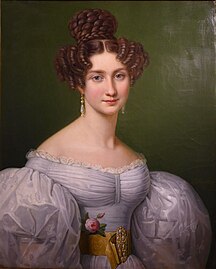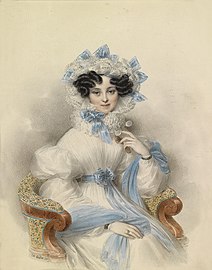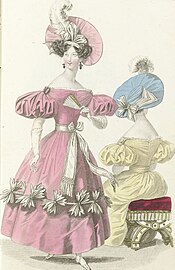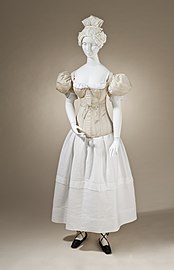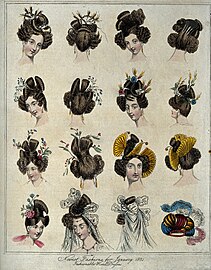User:Bleff/sandbox3

The Romantic era was a period in the history of Western fashion between the 1820s and the 1830s, during which costume reflected the movement of the same name that was flourishing in literature, music and the visual arts.[1][2] As a departure from Enlightenment ideals, the Romantic movement exalted imagination, emotion, individuality, and a fascination with past history.[2] In women's fashion, the era was characterised by the abandonment of the "Empire" silhouette and the Neoclassical influences of previous years in favour of a new "Romantic" style featuring a natural waistline, large puffed sleeves and wide skirts.[3]
Background[edit]
Women's fashion[edit]
The first half of the 1820s was a period of transition between the Empire fashion and the newer Romantic style.[4] The waistline, which was previously just below the bust, was gradually lowered until it was a few inches above its natural position by 1825.[4] Around the same time, women's dresses developed large sleeves, which continued to become larger, as well as gored skirts, which were gradually becoming wider and shorter.[4]
Women's undergarments included chemises, drawers, stays and petticoats.[4] Chemises were wide and knee-length, and typically had short sleeves.[4] There were no significant changes in the construction of women's drawers, which gained popularity across different social classes.[4] As fashion trends accentuated a narrower waist, stays were shortened and tightly laced to achieve the desired silhouette.[4] The expanding skirts of dresses were supported by multiple layers of petticoats, while bustles—small, padded accessories tied around the waist—created emphasis at the back of skirts.[4]
Image gallery[edit]
-
1826
-
1829
-
1830
-
1830–1835
-
1831
-
1831
Men's fashion[edit]
Children's fashion[edit]
See also[edit]
References[edit]
- ^ Bassett 2016, pp. 21.
- ^ a b Tortora & Marcketti 2015, p. 328.
- ^ Franklin, Harper (18 August 2020). "1820-1829". Fashion History Timeline. New York: Fashion Institute of Technology, State University of New York. Retrieved 1 January 2024.
- ^ a b c d e f g h Tortora & Marcketti 2015, p. 332.
Bibliography[edit]
- Bassett, Lynne Zacek (2016). Gothic to Goth: Romantic Era Fashion & Its Legacy. Hartford: Wadsworth Atheneum Museum of Art. ISBN 978-0918333285.
- Laver, James (1969). The Concise History of Costume and Fashion. New York: Harry N. Abrams. LCCN 79-92258.
- Tortora, Phyllis G.; Marcketti, Sara B. (2015) [1989]. Survey of Historic Costume (6th ed.). New York; London: Fairchild Books. ISBN 978-1-62892-167-0.

